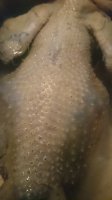fishdaughter
In the Brooder
- Jun 30, 2016
- 27
- 8
- 37
I've not done this before and wondered if the holey skin where the feathers were, should be so obvious?
I realise now that I should have plucked this young cockerel straight after killing him, but it was late last night so I hung him up and did it this morning.
I read several online things on how to pluck and prepare a chook, but I wonder if I followed the right advise?
Brief background - we have two teenage cockerels out of a hatch from earlier in the year and our chief cockerel attacked one yesterday...the youngster was badly injured on his neck and though I knew they would fight eventually, i didn't expect it quite so soon. I've never killed a hen/cock before and didn't want to cause any further suffering by breaking his neck wrong, so I decapitated him. It was the only thing I could think of that was quick and definite. I had intended to get a lesson from a neighbour prior to this point, but not managed it.
So, following online advice, I plunged the stiff dead bird in boiling water and then proceeded to pluck him. The feathers came out ok, but I did tear the skin round the wings. The skin now looks awful though as you can see in the photo. His whole body is covered in holes where the feathers were, and gooey stuff oozed from the holes as I pulled the feathers out. Is this normal? He is a young cockerel, maybe 4 months old and was just starting to perfect his cockadoodle-dooing. There isn't a scrap of fat on him...he's all long legs and scrawny body. I then ripped the skin further trying to wrestle the bloomin' crop out. So all in all he looks really unappetising.
Not sure I want to go through all that again.
I realise now that I should have plucked this young cockerel straight after killing him, but it was late last night so I hung him up and did it this morning.
I read several online things on how to pluck and prepare a chook, but I wonder if I followed the right advise?
Brief background - we have two teenage cockerels out of a hatch from earlier in the year and our chief cockerel attacked one yesterday...the youngster was badly injured on his neck and though I knew they would fight eventually, i didn't expect it quite so soon. I've never killed a hen/cock before and didn't want to cause any further suffering by breaking his neck wrong, so I decapitated him. It was the only thing I could think of that was quick and definite. I had intended to get a lesson from a neighbour prior to this point, but not managed it.
So, following online advice, I plunged the stiff dead bird in boiling water and then proceeded to pluck him. The feathers came out ok, but I did tear the skin round the wings. The skin now looks awful though as you can see in the photo. His whole body is covered in holes where the feathers were, and gooey stuff oozed from the holes as I pulled the feathers out. Is this normal? He is a young cockerel, maybe 4 months old and was just starting to perfect his cockadoodle-dooing. There isn't a scrap of fat on him...he's all long legs and scrawny body. I then ripped the skin further trying to wrestle the bloomin' crop out. So all in all he looks really unappetising.
Not sure I want to go through all that again.






